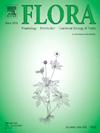Morphoanatomy, ontogeny and histochemistry of internal mucilage-secreting structures in the bracts and flowers of three genera of Bromeliaceae
IF 1.7
4区 生物学
Q3 ECOLOGY
引用次数: 0
Abstract
The presence of mucilaginous secretion in peduncles and inflorescences has been associated with certain species in the tribe Vrieseeae, within the genera Alcantarea, Vriesea, and Werauhia. Given the diversity of secretory structures and their ecological and functional significance, our objective was to describe the structures responsible for the secretions found in flowers and bracts of 16 species from the tribe Vrieseeae distributed across the three genera mentioned above, and to address questions regarding the type of structures and the chemical nature of the secretion, as well as their functional role. Samples of bracts, floral buds, and open flowers were analyzed at various developmental stages through anatomical and histochemical analyses using light microscopy and scanning electron microscopy. We documented and described two types of internal secretory structures that produce hydrophilic and mucilaginous secretions: secretory ducts in flowers and mucilage-secreting tissue in bracts. The presence of secretory structures varied in different regions depending on the species, being found in flowers (receptacle base and sepals) and floral and peduncle bracts. The mucilaginous secretion could play a protective role against desiccation, pathogens, and insects, similar to the function of colleter secretions. Furthermore, the mucilage stored in flowers may act as a polysaccharide reserve, aiding in the survival of these species under environmental stress, for example. The results obtained are relevant for expanding our understanding of secretory structures in Bromeliaceae, as well as for the conservation of the family in nature.
凤梨科三属苞片和花内部粘液分泌结构的形态解剖学、个体发生及组织化学研究
在花梗和花序中存在黏液分泌,这与在Alcantarea, Vriesea和Werauhia属的Vrieseeae部落的某些物种有关。考虑到分泌物结构的多样性及其生态和功能意义,我们的目标是描述分布在上述三个属的16种Vrieseeae部落花和苞片中发现的分泌物结构,并解决有关结构类型和分泌物的化学性质以及它们的功能作用的问题。通过光学显微镜和扫描电镜对不同发育阶段的苞片、花蕾和开放花进行解剖和组织化学分析。我们记录并描述了两种产生亲水性和粘液分泌物的内部分泌结构:花中的分泌管和苞片中的粘液分泌组织。分泌结构的存在因物种而异,存在于花(花托基部和萼片)、花和花梗苞片中。黏液分泌对干燥、病原体和昆虫具有保护作用,类似于收集器分泌物的功能。此外,储存在花中的粘液可以作为多糖储备,例如帮助这些物种在环境压力下生存。研究结果对扩大我们对凤梨科植物分泌结构的认识,以及在自然界中对凤梨科植物的保护具有重要意义。
本文章由计算机程序翻译,如有差异,请以英文原文为准。
求助全文
约1分钟内获得全文
求助全文
来源期刊

Flora
生物-植物科学
CiteScore
3.30
自引率
10.50%
发文量
130
审稿时长
54 days
期刊介绍:
FLORA publishes original contributions and review articles on plant structure (morphology and anatomy), plant distribution (incl. phylogeography) and plant functional ecology (ecophysiology, population ecology and population genetics, organismic interactions, community ecology, ecosystem ecology). Manuscripts (both original and review articles) on a single topic can be compiled in Special Issues, for which suggestions are welcome.
FLORA, the scientific botanical journal with the longest uninterrupted publication sequence (since 1818), considers manuscripts in the above areas which appeal a broad scientific and international readership. Manuscripts focused on floristics and vegetation science will only be considered if they exceed the pure descriptive approach and have relevance for interpreting plant morphology, distribution or ecology. Manuscripts whose content is restricted to purely systematic and nomenclature matters, to geobotanical aspects of only local interest, to pure applications in agri-, horti- or silviculture and pharmacology, and experimental studies dealing exclusively with investigations at the cellular and subcellular level will not be accepted. Manuscripts dealing with comparative and evolutionary aspects of morphology, anatomy and development are welcome.
 求助内容:
求助内容: 应助结果提醒方式:
应助结果提醒方式:


